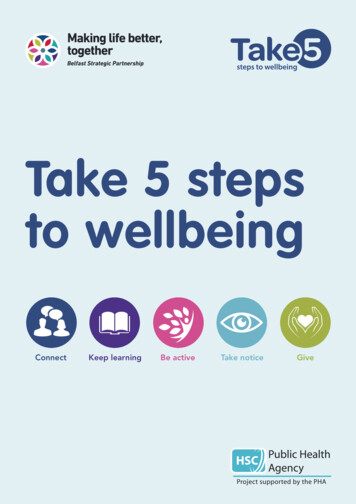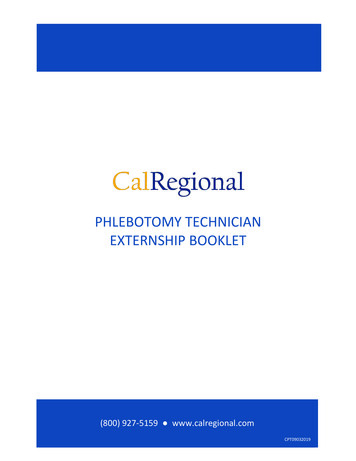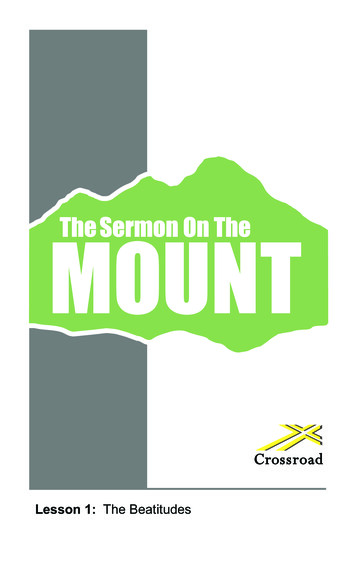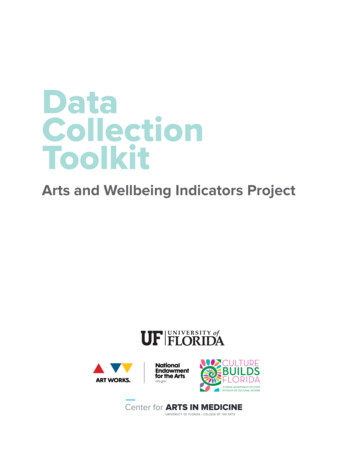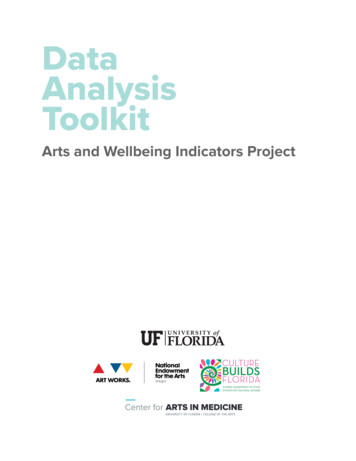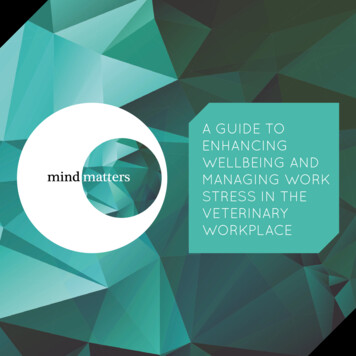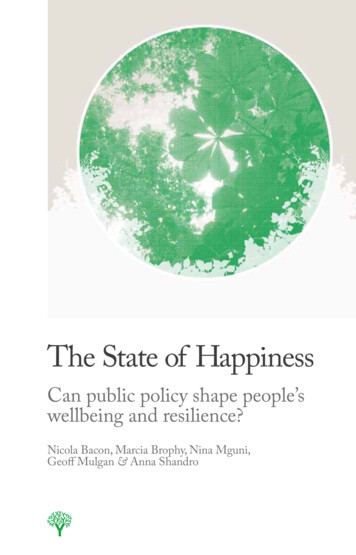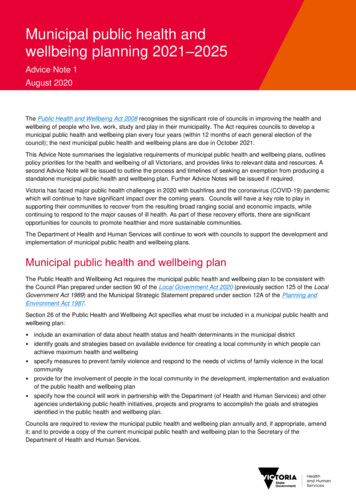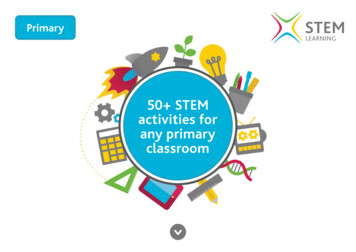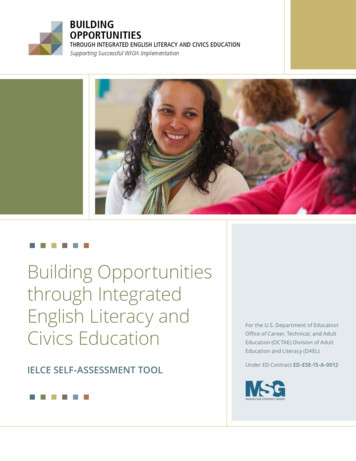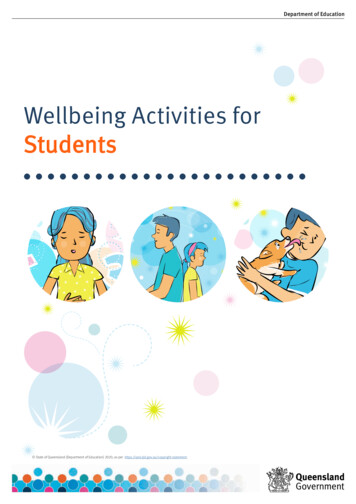
Transcription
Department of EducationWellbeing Activities forStudents State of Queensland (Department of Education) 2020, as per https://qed.qld.gov.au/copyright-statement.
Department of EducationContentsIntroduction 2Mindfulness Activities 4Guided Imagery 20Gratitude 23Physical Activities 26Young person self-care activities 36Suggested Weekly Wellbeing Routine 37References 381 State of Queensland (Department of Education) 2020, as per https://qed.qld.gov.au/copyright-statement.
Department of EducationIntroductionSupporting wellbeingSupporting the wellbeing of children and young people is an important part of what students, familiesand schools do every day. It is especially important to ensure that children and young people’s wellbeingis looked after in times of uncertainty and stress.Supporting wellbeing not only helps children and young people to feel happier and less anxious, it willalso help them to have positive interactions with the rest of the family and to learn more effectively.Using the wellbeing activitiesThe activities in this workbook are designed to give students themselves, as well as parents and carersand school staff suggested ways of supporting your students' wellbeing - either at home or as part ofclassroom activities at school.Given that schools know their students and communities best, your child’s school is best placed to guideyou about what resources will support your child’s learning at home.When should children and young people do wellbeing activities? Some schools include wellbeing activities for students as part of the school day. Regardless of whether wellbeing activities are done as part of the school day, children and youngpeople can do wellbeing activities at any time - on their own, with family members, or with a friend. Some parents or carers may chose to do wellbeing activities with their child or even with the wholefamily. Activities that support wellbeing are beneficial for people of all ages and can provide a greatopportunity for family members to bond and experience positive emotions together.Some of the activities in this booklet (for example “mindful breathing” and “body scan”) can be done everyday by your children or young people and are good examples of activities, that the whole family doestogether each morning or evening.Each activity in this book is designed to take between 5 and 15 minutes (but some can be done for longer ifyou wish). A suggested weekly wellbeing routine is included at the end of this book – but this is just a guideto help children and young people or families or teachers think about what routine would work best.2 State of Queensland (Department of Education) 2020, as per https://qed.qld.gov.au/copyright-statement.
Department of EducationCan wellbeing activities in this book be done withchildren and young people of all ages?Although this book is designed to be used with all school-aged children and young people, some activitiesin this book are best suited to Primary or Secondary aged students. A picture against the title of eachactivity lets you know whether the activity is best suited for:Children and youngpeople of all ages;Primary agedchildren; orSecondary agedchildren.While some activities in the book may be well-suited for children and young people with disability includingAutism Spectrum Disorder (ASD), specific resources for how to support the wellbeing of children and youngpeople with ASD can be found on the Department’s learning@home website at t-home/inclusion/autism.Description of each type of wellbeing activityMindfulness ActivitiesMindfulness is noticing what is happening right now in the present moment. When children and young peoplenotice what is happening around them, it can help them to calm down, especially if they are feeling sad, angry orfrustrated. Mindfulness can help them deal with difficult emotions, and can help them feel happy and feel good.A simple mindful breathing activity is a good place to start. Then try activities focussed on the senses, which arealso included in this book (e.g., mindful eating and mindful walking). Introduce mindfulness exercises whenthings are calm and participants in a good space. Mindfulness activities are a great way to connect as a family oras a class.GratitudeIt is always important, especially In difficult times, to appreciate the things that we may take for granted – likehaving a place to live, food, clean water, friends, family, even access to technology. Gratitude is pausing tonotice and appreciate these things, it’s taking a moment to reflect on how fortunate we are when something goodhappens — whether it’s a small thing or a big thing.Did you know that practising gratitude for 21 days in a row can re-train the brain to look for positives in the worldinstead of negatives? By simply being grateful, children and young people can experience a greater sense ofoptimism, happiness and calm.Physical ActivitiesIt is very important that children and young people engage in physical activity. Physical activity not only hasphysical benefits, but also benefits for mental health and wellbeing. Including the activities in this book into adaily routine will support a balanced approach to each day.Young Person Self-Care ActivitiesIt is important that children and young people have the opportunity to do activities that support their wellbeingand that they enjoy. A number of activities are listed in this book but there may be other activities that are notincluded that help to make children and young people feel happy. Even during difficult times, as much aspossible, children should continue to do the things that bring them joy.3 State of Queensland (Department of Education) 2020, as per https://qed.qld.gov.au/copyright-statement.
Department of EducationMindfulness Activities4 State of Queensland (Department of Education) 2020, as per https://qed.qld.gov.au/copyright-statement.
Department of EducationMindful hand washingWashing your hands is always important to keep you healthy and safe. Washing your hands provides a great timeto practice mindfulness and to be in the present moment.Instructions:1.Turn on the water and listen to the sound it makes as it comes out of the tap and goes down the drain.2.As you put soap on your hands, think in your head or say out loud what it feels like.3.As you rub the soap together in your hands, notice how slippery it is. Do you see bubbles coming upbetween your fingers?4.Now remember to wash your hands for 20 seconds. While you are doing this:a. focus on your hands and what the soap and water feel likeb. listen to the sound of the water and any other sounds you can hear around you.55.As you wash the soap off your hands, watch the bubbles and the water going down the drain – imagineyour worries going down the drain with the water.6.As you dry your hands on a hand towel, notice the feeling of the towel on your hands – is it soft? Orscratchy?7.When your hands are dry, take a moment to think. Now your hands are clean, you are ready for your nexttask. How does that make you feel?8.If you are still worried about anything, talk to someone at your home or at school about it - it alwayshelps to talk to someone else about how you're feeling. State of Queensland (Department of Education) 2020, as per https://qed.qld.gov.au/copyright-statement.
Department of EducationGlitter jarThis activity can teach children about how strong emotions can sometimes be overwhelming, and how to find calmwhen these strong emotions take over.Tip: make sure an adult helps you with this exerciseInstructionsMaterials: Jar or bottle that will not leak liquid1. Glitter and/or other small objects to add such asLEGO or beads2. Add a very small amount of food colouring to thewater and glue mixture. Food colouring3. Choose a glitter or object to add to the mixture. Imagine the object or glitter represents a feelingsuch as sadness, anger, fear, happiness, love oranything else you feel. Clear glue Hot (not boiling) water Spoon or stick to mixIn the jar or bottle, mix the clear glue and hot water.4. Add that glitter or object to the mixture.5.Keep adding glitter or objects and assigningfeelings to them.6. Fill the jar or bottle all the way to the top with thehot water.7. Mix the contents together with the spoon or stick.8. Make sure the lid is on tight!9. Shake the jar or bottle and watch all theobjects interact.Questions to think aboutWhat sorts of things or events make the glitter and objects (emotions) in the jar swirl? Say them out loud as youshake the jar. Distressing events Positive events Losing a game Spending time with family Missing friends Making a new friend Getting frustrated with a parent or sibling Getting a good grade Scary stories on the news Learning a new skill Sick family members Winning a gameNotice how it is hard to see through the jar with all these events going on.Now, watch what happens when you keep the jar still. Does the water begin to clear?The same thing happens in our mind when we stop for a little while and are mindful bad or hard feelings start to goaway and we can focus on other things that make us happy or calm.6 State of Queensland (Department of Education) 2020, as per https://qed.qld.gov.au/copyright-statement.
Department of EducationMindful breathingThis exercise can be used as a relaxing and thoughtful way to start the day, end the day or help relaxand calm your child.Tip: find somewhere quiet or put on some relaxing music in the background. For younger children, this canbe done with a parent or teacher guiding them. For older children, it can be done alone or with others.1.Find a comfortable place to sit or to lie down on your back.2. Place your hands on your stomach.3. Take a big deep breath – in through your nose and out through your mouth. Do this three times and then gentlyclose your eyes.4. Continue to slowly breathe in through your nose and count 1, 2, 3 in your head (or out loud).5.Hold your breath and count 1, 2, 3 in your head (or out loud).6. Slowly breathe out through your mouth and count 1, 2, 3 in your head (or out loud.7. Count 1, 2, 3 in your head (or out loud) and then breathe in again through your nose.8. Repeat these steps for five minutes and think about the questions below while you are breathing.9. When you have finished, gently open your eyes. Have a look at the room around you and think about how youfeel. Do you feel different compared to before the activity?Questions to think about What parts of your body move when you breathe in? Do different parts of your body move when you breathe out? Can you feel your hands moving? What does it feel like when you breathe in – where does the breath go? What does your breath sound like? What other sounds can you hear while you’re breathing? Does your body feel heavy or light while you’re breathing?7 State of Queensland (Department of Education) 2020, as per https://qed.qld.gov.au/copyright-statement.
Department of EducationSmell the flowersTip: try this with real flowers and plants outside! Adults should supervise young children1.Find a flower to smell or imagine you can smell a flower.2.Slowly breathe in through your nose and count 1, 2, 3 in your head.3.Hold your breath and count 1, 2, 3 in your head.4.Slowly breathe out through your mouth and count 1, 2, 3 in your head.5.Repeat with as many flowers you can think of or find.6.Younger children may then want to draw and colour in all the flowers they can think of or find.Questions to think about Which one did you think smelt the best and why? What did you smell when you breathed in? What did you smell when you breathed out? Could you feel the flower? What did it feel like? Did smelling the flowers remind you of any memory from your past?8 State of Queensland (Department of Education) 2020, as per https://qed.qld.gov.au/copyright-statement.
Department of EducationBest belly buddiesSince breathing is something that we do all the time, it is one of the best tools you have to bring you into thepresent moment, and there is no better way to engage young children than by using their favourite soft toy.Tip: pick your favourite soft toy as your belly buddy. Young children will need aparent to guide them while older children may do this independently.1.Lie on the ground on your back.2. Place your soft toy on top of your belly.3. Look at your toes.4. Slowly breathe in through your nose and count 1, 2, 3 in your head.5.Hold your breath and count 1, 2, 3 in your head.6. Slowly breathe out through your mouth and count 1, 2, 3 in your head.7. Repeat these steps for at least 3 minutes.Questions to think about Can you see the toy on your belly? What does it feel like having your toy on your belly? What did your toy do when you breathed in? What did your toy do when you breathed out? What does the air sound like when it comes in your nose? What does the air sound like when it comes out your mouth? What do you think it would feel like for your toy sitting on your belly?9 State of Queensland (Department of Education) 2020, as per https://qed.qld.gov.au/copyright-statement.
Department of EducationColourful breathingColour breathing is a simple stress reducing activity that can be learned quickly. It involves picturing a colour inyour mind that represents how you want to feel.Tip: this works best in a quiet and comfortable place. Young children will need aparent to guide them while older children may do this independently.1.Sit or stand so that your body is straight.2. Close your eyes.3. Think of a colour that makes you feelrelaxed or happy.4. Imagine that colour is all around you.5.Now think of a colour that makes you feelsad or angry.6. Slowly breathe in and imagine the relaxing or happycolour filling your lungs.7. As you breathe out imagine the colour that makes youfeel sad or angry mixing with the colour that makesyou feel relaxed or happy.8. Watch as the sad or angry colour mixes with therelaxed or happy colour and it disappears.9. Each time you breathe in, imagine more of yourrelaxing colour filling your body – your whole body isfilling with that colour and you are feeling relaxed.10. Each time you breathe out, see the sad or angrycolour leaving your body – your worries and sadnessare being let out and going far away.11. Keep going until you stop breathing out your sad orangry colour – now there is none of that colour leftand only the relaxing colour is in your body.10 State of Queensland (Department of Education) 2020, as per https://qed.qld.gov.au/copyright-statement.
Department of EducationBreathing togetherThis activity is very similar to mindful breathing, but with the added benefit of doing it with someone. Can be used atthe start or end of the day.Tip: this works best in a quiet and comfortable place1.Find a partner. This can be other students in the class, or, if you're at home, a brother,sister, mum, dad or someone else.2.Sit back-to-back with your partner.3.Sit up straight and gently close your eyes.4.Slowly breathe in through your nose and count 1, 2, 3 in your head.5.Hold the breath for 1, 2, 3.6.Slowly breathe out through your mouth and count 1, 2, 3 in your head.7.Repeat these steps for at least 3 minutes while you think about the questions below.Questions to think about How can you tell that your partner is breathing? Did you breathe at the same time as your partner? What does their breath feel like, is it fast or slow? What feelings did you feel while breathing with your partner? Do you feel closer to your partner after doing this exercise?11 State of Queensland (Department of Education) 2020, as per https://qed.qld.gov.au/copyright-statement.
Department of EducationBody scanThe purpose of a body scan is simply to notice and be aware of your body and where the stress ortense feelings may be.Tip: this works best somewhere comfortable and quiet. Young children will need aparent to guide them while older children may do this independently.1.d. Is there anything else touching this part of yourbody (like clothes, furniture)? What does itfeel like?Lie down on your back somewhere comfortable.2. Keep your body still.3. Take three deep breaths in and out and then gentlyclose your eyes.e. Does this body part feel cold or warm?f. Does this body part feel relaxed or tight?4. Slowly breathe in through your nose and count 1, 2,3 in your head.5.Hold the breath for 1, 2, 3.6. Slowly breathe out through your mouth and count 1,2, 3 in your head.7. You are going to start at the lower end of your bodyand work your way up.8. Focus on your feet and your toes for 10 seconds. Askyourself:a. How does this body part feel?b. Wiggle your toes – how does this feel?c. Can you feel this part of your body touchingthe floor? Which parts are touching and whichparts are not?12g. Does this body part feel heavy or light?9. Next ask the same questions about your ankles,then knees, then legs – all the way up your bodyuntil you reach your head.10. If a body part feels tight or heavy, slowly breathe inthrough your nose and count 1, 2, 3 in your head.11. Hold the breath for 1, 2, 3.12. Slowly breathe out through your mouth and count 1,2, 3 in your head.13. Repeat this until the body part feels relaxed.14. When you have reached the top of your head, gentlyopen your eyes. How does your body feel now? Doyou feel more relaxed? State of Queensland (Department of Education) 2020, as per https://qed.qld.gov.au/copyright-statement.
Department of EducationMindful eatingEating is something that is rarely done mindfully by young people or adults. Mindful eating is a valuable task forchildren to slow down the mind and become more focused on the present.Tip: choose a food you love to eat! Maybe a piece of your favourite fruit or a muffin. Youngchildren will need a parent to guide them while older children may do this independently.1.Sit somewhere comfortable and quiet.2. Close your eyes and hold the food you have chosen in your hand.a. What shape is the food?b. Is it heavy or light?3. Slowly breathe in through your nose and count 1, 2, 3 in your head.4. Hold the breath for 1, 2, 3.5.Slowly breathe out through your mouth and count 1, 2, 3 in your head.6. Hold the food up to your nose and take a deep breath in and count 1, 2, 3 in your head.a. What does the food smell like?b. How does the food make you feel?7. Take a small bite and keep the food on your tongue for a moment.a. What does the food feel like on your tongue?b. What can you taste?8. Swallow the food.a. What did the food taste like? Was it sweet or salty or bitter?b. What did the food feel like as it went down your throat?9. Try these steps again with bigger or smaller bites and ask the same questions.10. Keep going until you finish the food.13 State of Queensland (Department of Education) 2020, as per https://qed.qld.gov.au/copyright-statement.
Department of EducationMindful walkingA mindful walk is an excellent way to clear the mind of clutter and restore a sense of focus.Tip: if you are able to go outside into a garden or on a veranda/balcony, try this in the shade or wearing a hatand sunscreen. Young children will need an adult to guide them while older children may do this independently.1.c. Can you feel it under your feet? What does itfeel like?Find an area that you can walk in a straight linefor 10 steps.2. Decide where you will start and end your walk.d. Which part of your foot touches the ground first?3. Stand up straight at the start mark.e. Do you feel heavy or light when you walk?4. Slowly breathe in through your nose and count 1, 2,3 in your head.f. Do you make any sounds when you walk? Whatdoes it sound like?5.g. Are there any other noises around you?What are they?Hold the breath for 1, 2, 3.6. Slowly breathe out through your mouth and count 1,2, 3 in your head.7. Take 10 slow steps until you reach your end mark.9. Turn around and walk 10 steps back to yourstart mark.a. Are there any changes from the way you walkedthe first time? What are they?8. While you’re walking:a. Notice how your body moves with each step –pay attention to the lifting and falling of yourfoot. Notice movement in your legs and the restof your body. Notice how your body moves fromside to side.b. Are there any new noises this time?10. Try doing this exercise with and without shoes.b. What surface are you walking on?14 State of Queensland (Department of Education) 2020, as per https://qed.qld.gov.au/copyright-statement.a. Does it feel different when you wear shoes andwhen you do not?b. What are these differences?
Department of EducationMindful listeningPracticing mindful listening may help children to improve the way they interact with others by allowing them toactively listen to what they have to say.Tip: you can listen to sounds you find around the house or in the classroom, or play arecording of sounds that you might hear in nature or other calming music. Young childrenwill need a parent to guide them while older children may do this independently.1.Find a place where you will hear the chosen soundwithout too many other sounds getting in the way.2. Sit somewhere comfortable.3. Sit up straight.4. Gently close your eyes.5.Slowly breathe in through your nose and count 1, 2,3 in your head.6. Hold the breath for 1, 2, 3.8. Focus on the sound that you have chosen.9. If you feel like you start to think of other things, tryto change your attention back to the sound.10. Keep slowly breathing in and out and counting 1, 2,3 in your head.11. Keep your focus on the sound until it stops.12. When the sound has finished consider thequestions below.7. Slowly breathe out through your mouth and count 1,2, 3 in your head.Questions to think about How did your body feel while you were listening? Was it relaxed or tight? Was it easy or hard to focus on the sound? Did you hear any other sounds? What were they? How do you feel after this activity15 State of Queensland (Department of Education) 2020, as per https://qed.qld.gov.au/copyright-statement.
Department of EducationSpidey-SensesThis activity allows children to engage all of their senses while acting like their favourite superhero.Tip: try this exercise in a superhero costume or make your own with the help of an adult! Youngchildren will need an adult to guide them while older children may do this independently.1.Stand or sit up straight.12. Focus on what you can smell.2. Close your eyes.a. What do you smell in the air?3. Put your hands on your hips.b. Are there new smells that you didn’tnotice before?4. Slowly breathe in through your nose and count 1, 2,3 in your head.5.Hold the breath for 1, 2, 3.6. Slowly breathe out through your mouth and count 1,2, 3 in your head.c. Where do you think the new smell iscoming from?13. Focus on what you can taste.a. What can you taste?b. Does your mouth feel dry or wet?7. Think of a superhero and imagine you are thatsuperhero.8. You might imagine that you are Spiderman and turnon your ‘Spidey Senses’ or have the super-focusedsmell, taste, touch, hearing, or sight that Supermanhas when protecting the world.c. Do you have a sweet, sour or salty taste inyour mouth?d. Can you feel your tongue in your mouth?14. Focus on what you can touch.a. Can you feel your feet? What are they doing?9. Open your eyes!b. Can you feel what you are sitting or standing on?Is it soft or hard? Wet or dry? Smooth or bumpy?Cold or hot?10. You can now see, hear, smell, taste and touch likethat superhero!11. Focus on the sounds you can hear.a. What can you hear around you?b. Can you notice sounds you didn’t hear before?What are they?15. Keep your superhero senses switched on as longas you like. Think to yourself or tell someone how itmakes you feel being a superhero.c. Can you hear anything outside? What is it?d. How many different sounds can you hear?Focuson what you can see.e. What can you see now that you did not before?f. Can you see small things?g. What colours do you see?16 State of Queensland (Department of Education) 2020, as per https://qed.qld.gov.au/copyright-statement.
Department of EducationTest your sensesAn excellent activity to engage the five senses and notice the difference in how each sense is engaged.Tip: this works best in a quiet and comfortable place. Young children will need aparent to guide them while older children may do this independently.1.Slowly breathe in through your nose and count 1, 2, 3 in your head.2. Hold the breath for 1, 2, 3.3. Slowly breathe out through your mouth and count 1, 2, 3 in your head.See1.SmellLook around the room you are in.2. Notice 5 things as you look around. Try to pick outthings you would not normally notice.1.2. Focus on 2 things you can smell.a. What different scents can you pick uparound you?3. Focus on the shapes, colours and different patternsthat surround you.b. Are there strong smells around you?What are they?4. Write down the 5 things you can see.c. Are there familiar or new smells?Feel1.d. Do you like the smells?Now, close your eyes. Bring your attention to thethings you are currently feeling.2. Can you focus on 4 things you can feel?a. Where are your hands? Are they touchinganything? What does it feel like?Taste1.b. Can you feel your shirt against your skin?a. How your tongue feels resting betweenyour teeth?c. What about your body? Can you feel where youare tense or relaxed?b. Can you still taste the last thing you ate?e. Can you feel what you are sitting on? Is itsoft or hard? Wet or dry? Smooth or bumpy?Cold or hot?c. Can you taste something that you canalso smell?Open your eyes and write down or draw all the thingsyou felt, heard, smelt and tasted.HearKeep your eyes closed.2. Focus on 3 things you can hear.a. What sounds can you hear around you? Can younotice anything different to before?b. Can you hear noises in other rooms?c. Outside?17Keep your eyes closed.2. Focus on 1 thing you can taste.d. Can you feel the air around you? Is it warm orcold? Is there a breeze?1.Keep your eyes closed. State of Queensland (Department of Education) 2020, as per https://qed.qld.gov.au/copyright-statement.
Department of EducationMindful SafariEveryone spends a lot of time indoors during the day. This activity allows children to get outside and move andrefresh the mind.Tip: if you are able to go outside into a garden or onto a veranda and you’re in thesun, wear a hat and sunscreen while exploring outside! Young children will need aparent to guide them while older children may do this independently.Explain that you are going to go on an exciting Safariadventure to look for animals that jump, fly, crawl. Tolook for plants and objects that may be big or small andto listen for different sounds.1.6. Focus on something such as a plant, animal orobject you can see.a. What does it look like?b. Is it small or big?Slowly breathe in through your nose and count 1, 2,3 in your head.c. What colour is it?d. Does it smell? What does it smell like?2. Hold the breath for 1, 2, 3.e. Can you safely touch it? What does it feel like?3. Slowly breathe out through your mouth and count 1,2, 3 in your head.4. Now, make sure to move slowly and stay quiet andcalm so you don’t scare away the animals.5.Engage your super-senses of sight, smell, hearingand touch while you walk around.f. Does it move? How does it move?g. Have you seen this before?7. Write or draw all the things you find! Show someoneelse in your classroom or home of all of the thingsthat you have discovered – you could even write astory about it to read to them later.Alternative Step 6: Rainbow WalkInstead of focusing on an object, plant or animal, take a walk, and look for something red, orange, yellow, green, blue,and purple. Keep going through the colours, in order, until the end of your walk.18 State of Queensland (Department of Education) 2020, as per https://qed.qld.gov.au/copyright-statement.
Department of EducationMindful heartbeatThe mindful heartbeat is a good exercise to focus on the sensations in the body and when a child may be stressed oranxious.Tip: this works best in a quiet and comfortable place. Young children will need aparent to guide them while older children may do this independently.1.Sit somewhere comfortable.7. Open your eyes and stand up.2. Close your eyes.8. Jump on the spot or do star jumps 10 times.3. Slowly breathe in through your nose and count 1, 2,3 in your head.9. Sit back down and close your eyes.4. Hold the breath for 1, 2, 3.5.Slowly breathe out through your mouth and count 1,2, 3 in your head.6. Put your fingers somewhere on your body where youbest feel your heartbeat (this can be your neck, wristor over your heart). Is your heart beating fast or slow? Is your breathing different? How do you feel? Relaxed, tense, excited?1910. Put your fingers in the same spot to feel yourheartbeat. What has changed? Is your heartbeat slower or quicker? Are you breathing slower or quicker? Are there any other changes? Are you sweating?11. Keep your eyes closed until your heartbeat slowsdown again.12. Once your heartbeat has returned to the samespeed as before you did the jumps, open your eyes. State of Queensland (Department of Education) 2020, as per https://qed.qld.gov.au/copyright-statement.
Department of EducationGuided ImageryBelow are three guided imagery activities. Although the story-like nature of the activity may appeal more toyounger children
people can do wellbeing activities at any time - on their own, with family members, or with a friend. Some parents or carers may chose to do wellbeing activities with their child or even with the whole family. Activities that support
